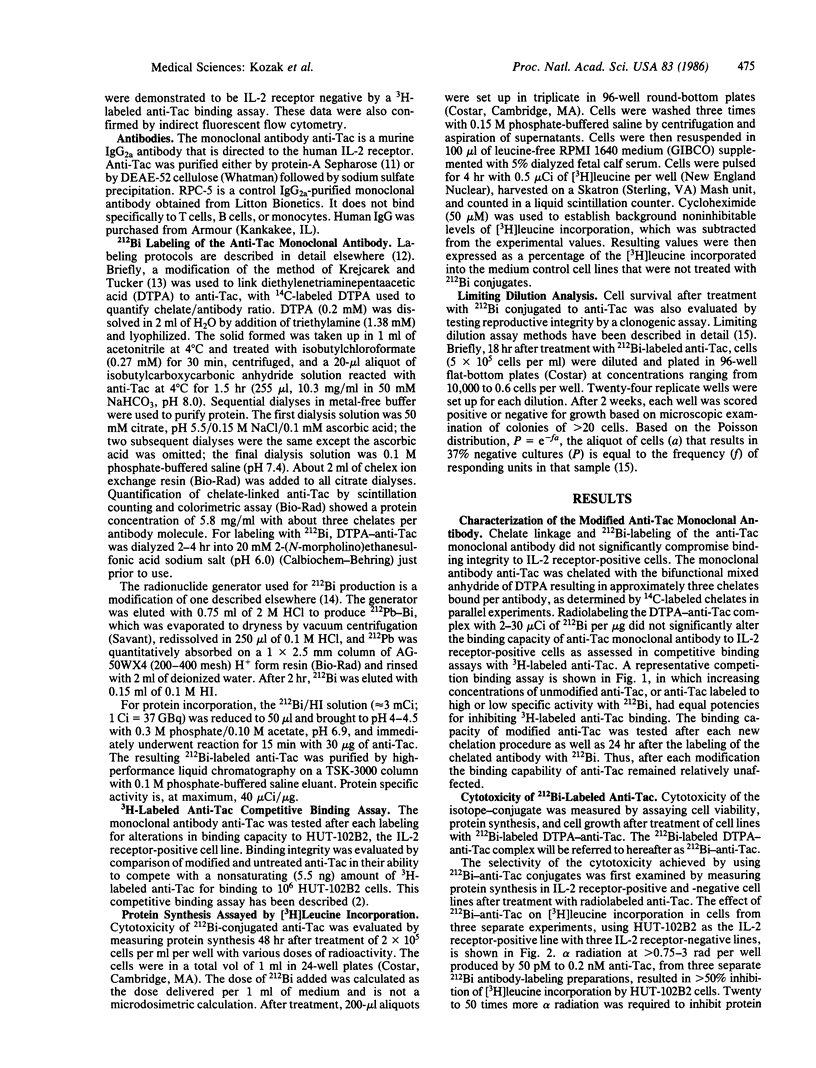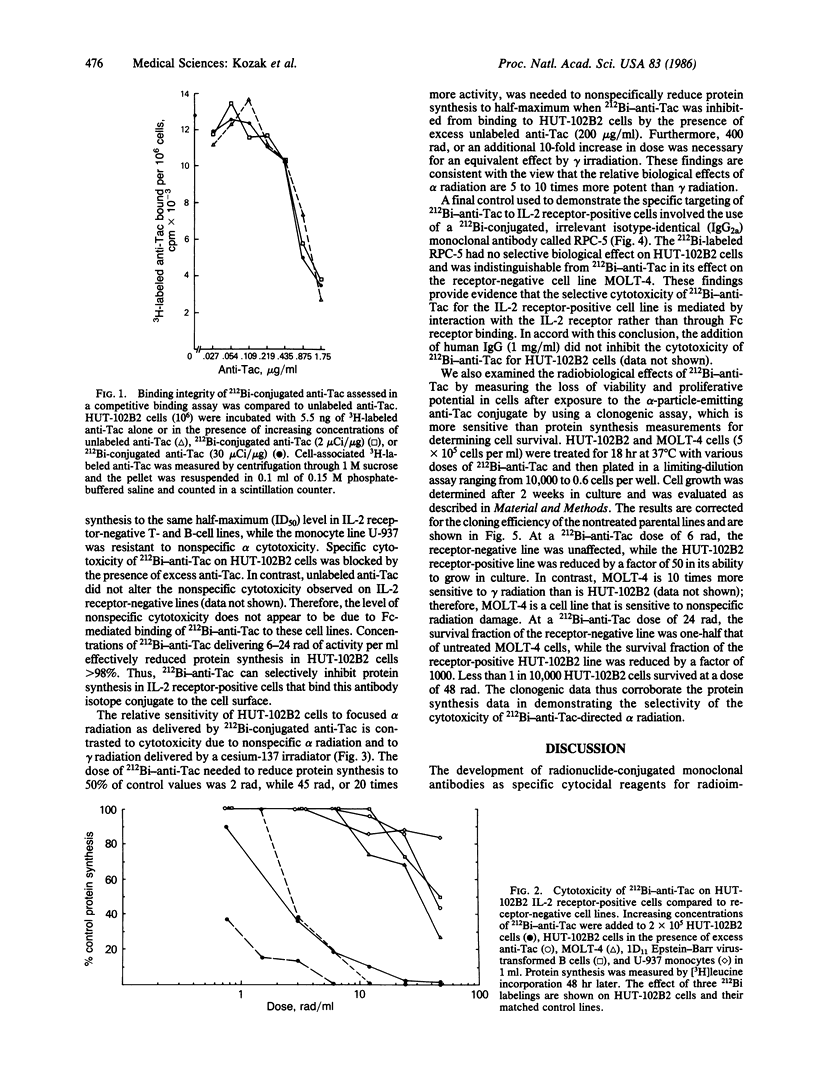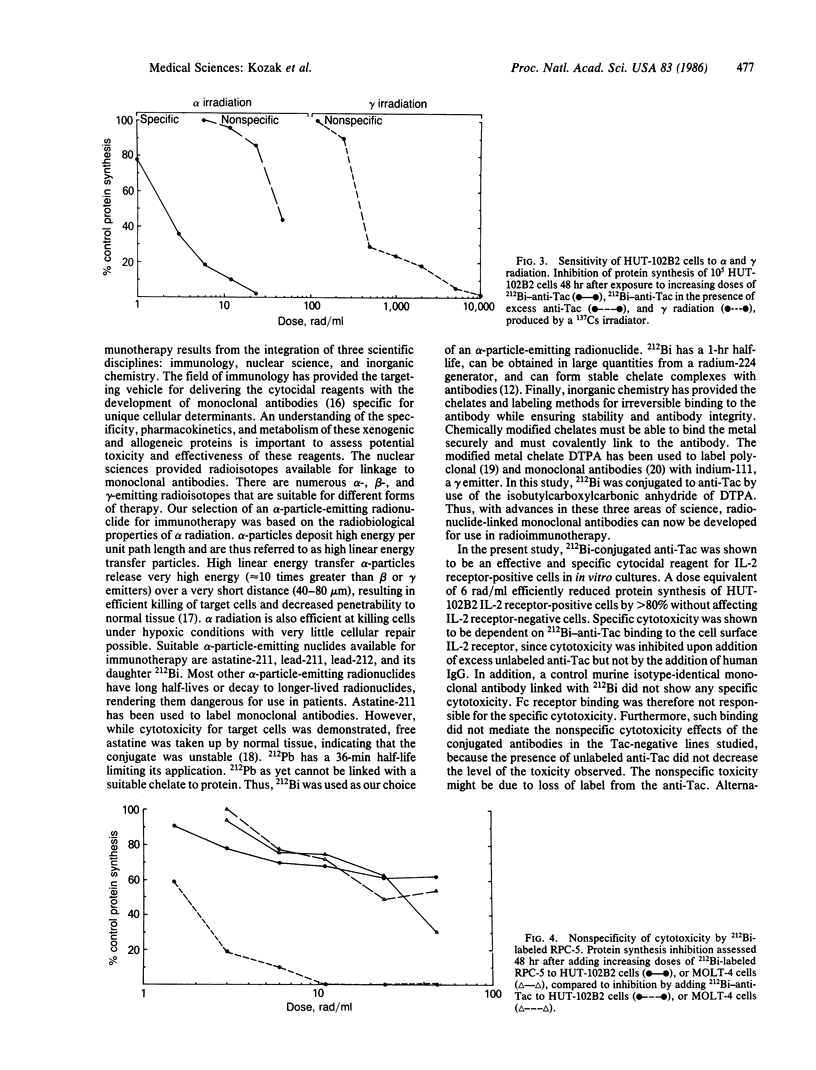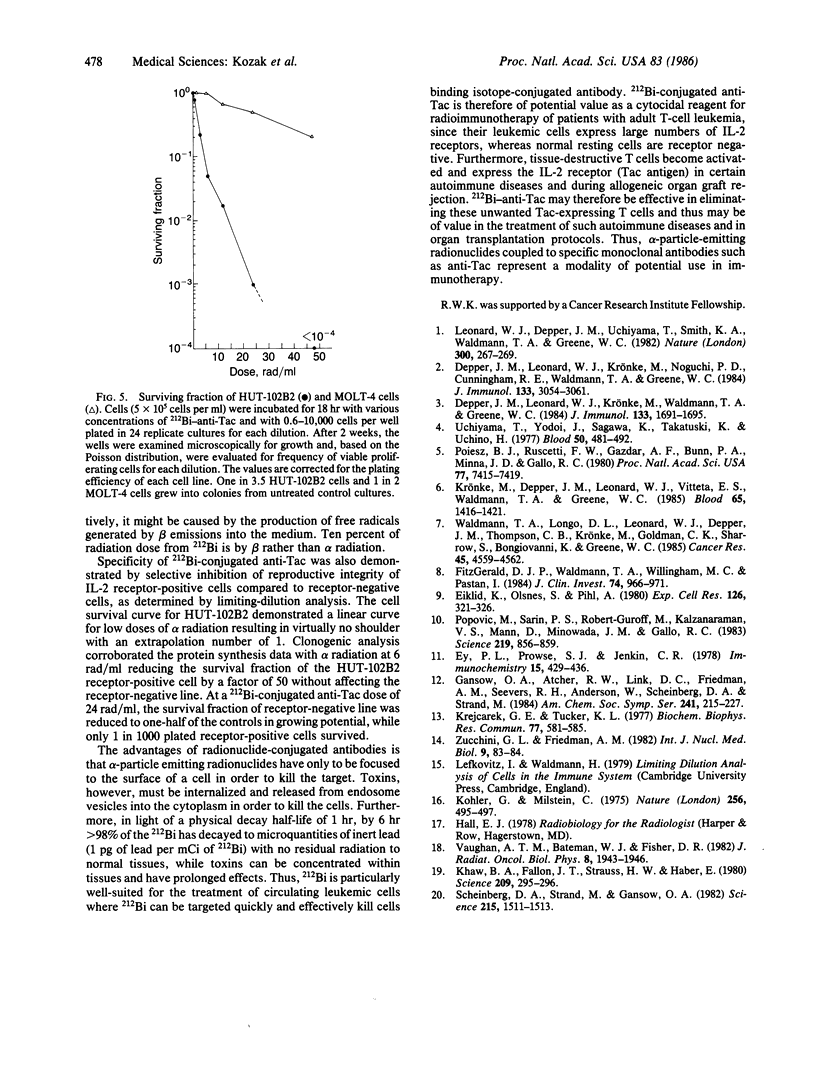Abstract
Anti-Tac, a monoclonal antibody directed to the human interleukin 2 (IL-2) receptor, has been successfully conjugated to the alpha-particle-emitting radionuclide bismuth-212 by use of a bifunctional ligand, the isobutylcarboxycarbonic anhydride of diethylenetriaminepentaacetic acid. The physical properties of 212Bi are appropriate for radioimmunotherapy in that it has a short half-life, deposits its high energy over a short distance, and can be obtained in large quantities from a radium generator. Antibody specific activities of 1-40 microCi/microgram (1 Ci = 37 GBq) were achieved. Specificity of the 212Bi-labeled anti-Tac was demonstrated for the IL-2 receptor-positive adult T-cell leukemia line HUT-102B2 by protein synthesis inhibition and clonogenic assays. Activity levels of 0.5 microCi or the equivalent of 12 rad/ml of alpha radiation targeted by anti-Tac eliminated greater than 98% the proliferative capabilities of HUT-102B2 cells with more modest effects on IL-2 receptor-negative cell lines. Specific cytotoxicity was blocked by excess unlabeled anti-Tac but not by human IgG. In addition, an irrelevant control monoclonal antibody of the same isotype labeled with 212Bi was unable to target alpha radiation to cell lines. Therefore, 212Bi-labeled anti-Tac is a potentially effective and specific immunocytotoxic reagent for the elimination of IL-2 receptor-positive cells. These experiments thus provide the scientific basis for use of alpha-particle-emitting radionuclides in immunotherapy.
Full text
PDF




Selected References
These references are in PubMed. This may not be the complete list of references from this article.
- Depper J. M., Leonard W. J., Krönke M., Noguchi P. D., Cunningham R. E., Waldmann T. A., Greene W. C. Regulation of interleukin 2 receptor expression: effects of phorbol diester, phospholipase C, and reexposure to lectin or antigen. J Immunol. 1984 Dec;133(6):3054–3061. [PubMed] [Google Scholar]
- Depper J. M., Leonard W. J., Krönke M., Waldmann T. A., Greene W. C. Augmented T cell growth factor receptor expression in HTLV-1-infected human leukemic T cells. J Immunol. 1984 Oct;133(4):1691–1695. [PubMed] [Google Scholar]
- Eiklid K., Olsnes S., Pihl A. Entry of lethal doses of abrin, ricin and modeccin into the cytosol of HeLa cells. Exp Cell Res. 1980 Apr;126(2):321–326. doi: 10.1016/0014-4827(80)90270-0. [DOI] [PubMed] [Google Scholar]
- Ey P. L., Prowse S. J., Jenkin C. R. Isolation of pure IgG1, IgG2a and IgG2b immunoglobulins from mouse serum using protein A-sepharose. Immunochemistry. 1978 Jul;15(7):429–436. doi: 10.1016/0161-5890(78)90070-6. [DOI] [PubMed] [Google Scholar]
- FitzGerald D. J., Waldmann T. A., Willingham M. C., Pastan I. Pseudomonas exotoxin-anti-TAC. Cell-specific immunotoxin active against cells expressing the human T cell growth factor receptor. J Clin Invest. 1984 Sep;74(3):966–971. doi: 10.1172/JCI111516. [DOI] [PMC free article] [PubMed] [Google Scholar]
- Khaw B. A., Fallon F. T., Strauss H. W., Haber E. Myocardial infarct imaging of antibodies to canine cardiac myosin with indium-111-diethylenetriamine pentaacetic acid. Science. 1980 Jul 11;209(4453):295–297. doi: 10.1126/science.7384803. [DOI] [PubMed] [Google Scholar]
- Krejcarek G. E., Tucker K. L. Covalent attachment of chelating groups to macromolecules. Biochem Biophys Res Commun. 1977 Jul 25;77(2):581–585. doi: 10.1016/s0006-291x(77)80018-1. [DOI] [PubMed] [Google Scholar]
- Krönke M., Depper J. M., Leonard W. J., Vitetta E. S., Waldmann T. A., Greene W. C. Adult T cell leukemia: a potential target for ricin A chain immunotoxins. Blood. 1985 Jun;65(6):1416–1421. [PubMed] [Google Scholar]
- Köhler G., Milstein C. Continuous cultures of fused cells secreting antibody of predefined specificity. Nature. 1975 Aug 7;256(5517):495–497. doi: 10.1038/256495a0. [DOI] [PubMed] [Google Scholar]
- Leonard W. J., Depper J. M., Uchiyama T., Smith K. A., Waldmann T. A., Greene W. C. A monoclonal antibody that appears to recognize the receptor for human T-cell growth factor; partial characterization of the receptor. Nature. 1982 Nov 18;300(5889):267–269. doi: 10.1038/300267a0. [DOI] [PubMed] [Google Scholar]
- Leonard W. J., Depper J. M., Uchiyama T., Smith K. A., Waldmann T. A., Greene W. C. A monoclonal antibody that appears to recognize the receptor for human T-cell growth factor; partial characterization of the receptor. Nature. 1982 Nov 18;300(5889):267–269. doi: 10.1038/300267a0. [DOI] [PubMed] [Google Scholar]
- Poiesz B. J., Ruscetti F. W., Gazdar A. F., Bunn P. A., Minna J. D., Gallo R. C. Detection and isolation of type C retrovirus particles from fresh and cultured lymphocytes of a patient with cutaneous T-cell lymphoma. Proc Natl Acad Sci U S A. 1980 Dec;77(12):7415–7419. doi: 10.1073/pnas.77.12.7415. [DOI] [PMC free article] [PubMed] [Google Scholar]
- Popovic M., Sarin P. S., Robert-Gurroff M., Kalyanaraman V. S., Mann D., Minowada J., Gallo R. C. Isolation and transmission of human retrovirus (human t-cell leukemia virus). Science. 1983 Feb 18;219(4586):856–859. doi: 10.1126/science.6600519. [DOI] [PubMed] [Google Scholar]
- Scheinberg D. A., Strand M., Gansow O. A. Tumor imaging with radioactive metal chelates conjugated to monoclonal antibodies. Science. 1982 Mar 19;215(4539):1511–1513. doi: 10.1126/science.7199757. [DOI] [PubMed] [Google Scholar]
- Uchiyama T., Yodoi J., Sagawa K., Takatsuki K., Uchino H. Adult T-cell leukemia: clinical and hematologic features of 16 cases. Blood. 1977 Sep;50(3):481–492. [PubMed] [Google Scholar]
- Vaughan A. T., Bateman W. J., Fisher D. R. The in vivo fate of a 211At labelled monoclonal antibody with known specificity in a murine system. Int J Radiat Oncol Biol Phys. 1982 Nov;8(11):1943–1946. doi: 10.1016/0360-3016(82)90453-9. [DOI] [PubMed] [Google Scholar]
- Zucchini G. L., Friedman A. M. Isotopic generator for 212Pb and 212Bi. Int J Nucl Med Biol. 1982;9(1):83–84. doi: 10.1016/0047-0740(82)90082-1. [DOI] [PubMed] [Google Scholar]


